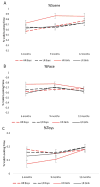Enhanced Social Attention in Female Infant Siblings at Risk for Autism
- PMID: 26903252
- PMCID: PMC5812780
- DOI: 10.1016/j.jaac.2015.11.016
Enhanced Social Attention in Female Infant Siblings at Risk for Autism
Abstract
Objective: Sexual dimorphism in autism spectrum disorders (ASD) is a well-recognized but poorly understood phenomenon. Females are four times less likely to be diagnosed with ASD than males and, when diagnosed, are more likely to exhibit comorbid anxiety symptoms. One of the key phenotypic features of ASD is atypical attention to socially relevant stimuli. Eye-tracking studies indicate atypical patterns of spontaneous social orienting during the prodromal and early syndromic stages of ASD. However, there have been no studies evaluating sex differences in early social orienting and their potential contribution to later outcomes.
Method: We examined sex differences in social orienting in 6-, 9-, and 12-month-old infants at high genetic risk for ASD (n = 101) and in low-risk controls (n = 61), focusing on neurobehavioral measures of function across a spectrum of autism risk.
Results: Results suggest that, between 6 and 12 months of age, a period highly consequential for the development of nonverbal social engagement competencies, high-risk females show enhanced attention to social targets, including faces, compared to both high-risk males and low-risk males and females. Greater attention to social targets in high-risk infants was associated with less severe social impairments at 2 years.
Conclusion: The results suggest an alternative expression of autism risk in females, which manifests in infancy as increased attention toward socially relevant stimuli. This increased attention may serve as a female protective factor against ASD by providing increased access to social experiences in early development.
Keywords: attention; autism; infancy; protective factors; sex differences.
Copyright © 2016 American Academy of Child and Adolescent Psychiatry. Published by Elsevier Inc. All rights reserved.
Conflict of interest statement
Disclosure: Dr. Shic has received research funding from Hoffmann-La Roche Ltd and Janssen Research and Development, LLC. Drs. Chawarska, Macari, Powell, and Ms. DiNicola report no biomedical financial interests or potential conflicts of interest.
Figures


Comment in
-
Attention Finally Being Paid to Girls at Risk of Autism.J Am Acad Child Adolesc Psychiatry. 2016 Mar;55(3):159-60. doi: 10.1016/j.jaac.2015.12.013. J Am Acad Child Adolesc Psychiatry. 2016. PMID: 26903248 No abstract available.
References
-
- American Psychiatric Association. Diagnostic and statistical manual of mental disorders: DSM-5. Washington DC: American Psychiatric Pub; 2013.
-
- Baio J. Surveillance Summaries. 3. Vol. 61. Centers for Disease Control and Prevention; 2012. Prevalence of Autism Spectrum Disorders: Autism and Developmental Disabilities Monitoring Network, 14 Sites, United States, 2008. Morbidity and Mortality Weekly Report. - PubMed
-
- Szatmari P, Liu X-Q, Goldberg J, et al. Sex differences in repetitive stereotyped behaviors in autism: Implications for genetic liability. Am J Med Genet B Neuropsychiatr Genet. 2012;159:5–12. - PubMed
-
- Zwaigenbaum L, Bryson SE, Szatmari P, et al. Sex Differences in Children with Autism Spectrum Disorder Identified Within a High-Risk Infant Cohort. J Autism Dev Disord. 2012;42:2585–2596. - PubMed
Publication types
MeSH terms
Grants and funding
LinkOut - more resources
Full Text Sources
Other Literature Sources
Medical

